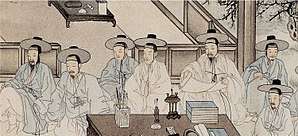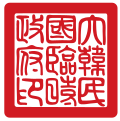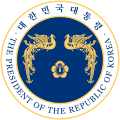Emblem of South Korea
| National Emblem of the Republic of Korea 대한민국의 국장 | |
|---|---|
 | |
| Details | |
| Armiger | Republic of Korea |
| Adopted | 1963 (modified in 1997) |
| Escutcheon | Taegeuk; Hibiscus syriacus |
 |
| Part of a series on the |
| Culture of Korea |
|---|
| History |
|
Music and performing arts |
|
|
Monuments |
|
National symbols of Korea |
|
The National Emblem of the Republic of Korea (Hangul: 대한민국의 국장 / Hanja: 大韓民國의 國章) consists of the taeguk symbol present on the country's national flag surrounded by five stylized petals and a ribbon bearing the inscription of the official Korean name of the country (Daehan Minguk), in Hangul characters. The Taegeuk represents peace and harmony. The five petals all have meaning and are related to South Korea's national flower, the Hibiscus syriacus, or Rose of Sharon (mugunghwa (무궁화/無窮花). The emblem was adopted in 1963. The flower and yin-yang symbols are traditional symbols of the "Korean race".[1]
Gallery
 Seal of Provisional Government of the Republic of Korea, 1919–1948
Seal of Provisional Government of the Republic of Korea, 1919–1948 Emblem of the Provisional Government of the Republic of Korea, 1919–1948
Emblem of the Provisional Government of the Republic of Korea, 1919–1948.svg.png) Emblem of South Korea, 1948–1963
Emblem of South Korea, 1948–1963.svg.png) Emblem of South Korea, 1963–1997
Emblem of South Korea, 1963–1997
 Emblem of the National Government, a stylized Taeguk.
Emblem of the National Government, a stylized Taeguk. Emblem of the Prime Minister. A rose of Sharon enclosed by another.
Emblem of the Prime Minister. A rose of Sharon enclosed by another. Emblem of the National Assembly. The word "국회" meaning 'National Assembly' (gukhoe / 國會 in Hanja) appears in Hangul in the center of a rose of Sharon.
Emblem of the National Assembly. The word "국회" meaning 'National Assembly' (gukhoe / 國會 in Hanja) appears in Hangul in the center of a rose of Sharon.
See also
- Flag of South Korea
- Emblem of North Korea
- Imperial Seal of Korea, uses plum blossom instead
- Taegeuk
References
- ↑ Myers, Brian Reynolds (2011). "North Korea's state-loyalty advantage". Free Online Library. Archived from the original on 20 May 2018. Retrieved 20 May 2018.
The state emblem (adopted in 1963) is a yin-yang symbol on a rose of Sharon--another purely racial symbol.
External links
This article is issued from
Wikipedia.
The text is licensed under Creative Commons - Attribution - Sharealike.
Additional terms may apply for the media files.
